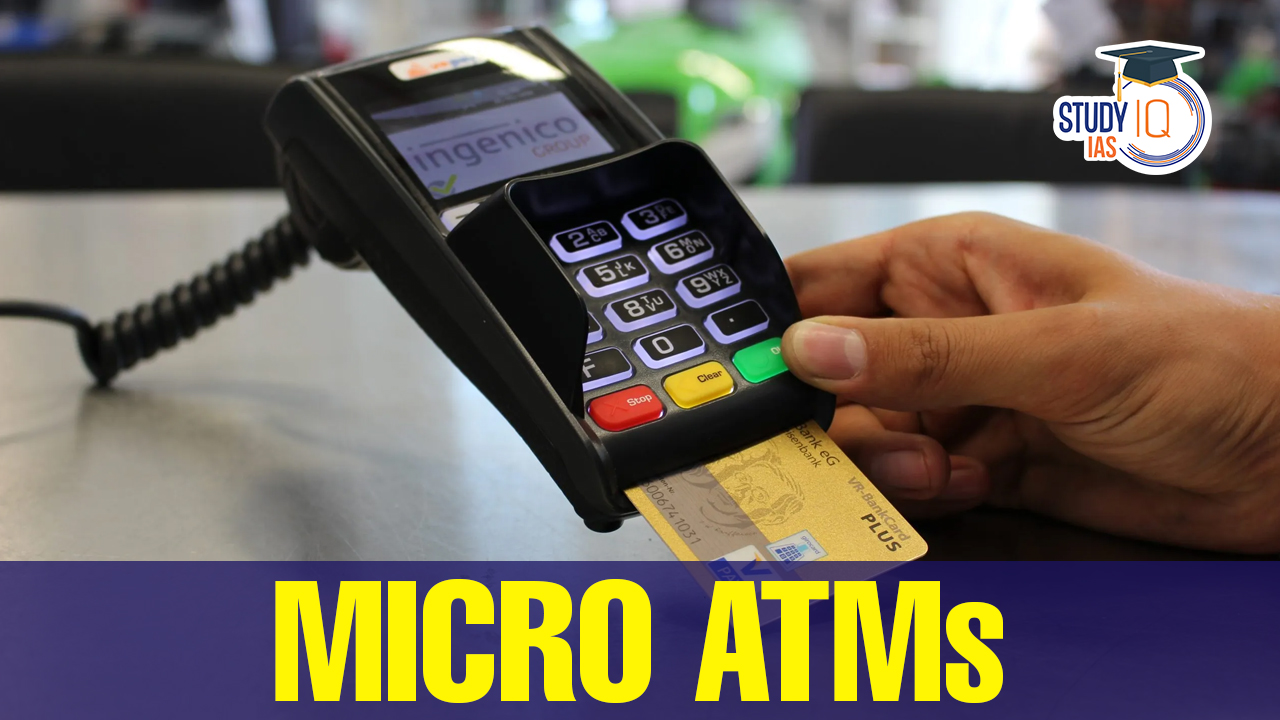Table of Contents
Micro ATMs
Micro ATMs are compact electronic devices that provide basic banking services in areas with limited banking infrastructure. They enable customers to perform transactions such as cash withdrawals, balance inquiries, and fund transfers using their debit cards or biometric authentication, bridging the gap between traditional banking and underserved populations.
Read about: MCLR Marginal Cost of Funds Based Lending Rate
Benefits of Micro ATMs
The benefits of micro ATMs include:
| Benefits | Details |
| Financial Inclusion | Micro ATMs bring banking services to underserved areas, allowing people in remote locations to access basic financial services. |
| Convenience | Micro ATMs provide convenient banking services, allowing customers to withdraw cash, check their account balance, and transfer funds without having to travel long distances to a bank branch. |
| Cost-Effective | Micro ATMs are cost-effective compared to traditional ATMs, making it feasible for banks to extend their services to rural and remote areas without the need for significant infrastructure investments. |
| Enhanced Security | Micro ATMs often incorporate biometric authentication, ensuring secure transactions and reducing the risk of fraudulent activities. |
| Empowerment of Business Correspondents |
Micro ATMs create opportunities for business correspondents or banking agents to offer banking services in their communities, generating income and employment opportunities. |
| Digital Transactions |
Micro ATMs promote digital transactions by facilitating electronic payments and reducing reliance on cash, thereby fostering financial digitization and reducing the risk associated with carrying physical currency. |
| Government Schemes |
Micro ATMs play a crucial role in disbursing government benefits, subsidies, and welfare payments directly to beneficiaries, ensuring transparency and efficiency in the delivery of social welfare programs. |
Read about: Indian Financial System
How Micro ATMs Work?
Micro ATMs work in the following steps:
Authentication
The customer inserts their debit card into the micro ATM or uses biometric authentication such as fingerprint or Aadhaar verification.
Transaction Selection
The customer selects the desired transaction from the available options, such as cash withdrawal, balance inquiry, fund transfer, or bill payment.
Transaction Processing
The micro ATM connects to the bank’s server via a secure network, either through a mobile network or a GPRS connection. The transaction details are encrypted and sent for verification and processing.
Verification
The bank’s server verifies the customer’s details and checks the availability of funds in the account. If the transaction is authenticated successfully, the server generates an approval code.
Transaction Completion
The micro ATM displays the transaction details and prompts the customer to enter the desired amount for withdrawal or other transaction types. Once the amount is entered, the micro ATM dispenses the cash, updates the account balance, or completes the desired transaction.
Receipt Generation
A receipt is generated, providing details of the transaction, including the transaction type, amount, account balance, and reference number. The customer can keep the receipt for their records.
It’s important to note that micro ATMs rely on a network connection and require regular maintenance to ensure smooth functioning. Additionally, the specific steps and interface of micro ATMs may vary slightly depending on the manufacturer and the banking institution.
Read about: Difference Between Organised and Unorganised Sector
Use of Micro ATMs in India
Micro ATMs have played a significant role in promoting financial inclusion in India. In the Indian context, micro ATMs are portable handheld devices used by banking correspondents or agents to provide banking services in remote and rural areas. The following points highlight the importance and use of Micro ATMs in India.
Banking Correspondents (BCs)
Micro ATMs are typically operated by BCs, who are authorized individuals or entities appointed by banks to offer basic banking services on their behalf. BCs can be individuals, NGOs, or business entities.
Service Offered
Micro ATMs in India enable customers to perform various banking transactions, including cash withdrawals, balance inquiries, fund transfers, account opening, Aadhaar-based transactions, and bill payments.
Connectivity
Micro ATMs in India are often equipped with multiple connectivity options such as GPRS, mobile networks, or biometric-enabled devices for Aadhaar authentication.
Financial Inclusion
Micro ATMs have played a crucial role in expanding banking services to unbanked and underbanked regions in India. They have helped in bridging the gap between rural areas and formal banking by bringing basic financial services to the doorstep of people who lack access to traditional banking infrastructure.
Government Initiatives
Micro ATMs have been instrumental in implementing various government schemes and programs in India. They have facilitated the direct transfer of subsidies, social welfare benefits, and other government payments to beneficiaries, ensuring transparency and reducing leakages.
Cash Management
Micro ATMs also assist in cash management by reducing the need for physical cash handling. Instead of carrying large amounts of cash, beneficiaries can withdraw their entitlements as per their requirements, minimizing the risk associated with cash transportation.
Read about: National Payments Corporation of India
Micro ATMs UPSC
Understanding the concept of micro ATMs is important for UPSC aspirants as it relates to various aspects of the UPSC Syllabus, such as the Indian Economy and Governance. Micro ATMs have been a significant tool in promoting financial inclusion, a key aspect of socio-economic development in India. Aspirants preparing for UPSC exams can expect questions on topics like microfinance, banking reforms, government schemes for financial inclusion, and the role of technology in inclusive growth. Additionally, UPSC Online Coaching platforms and UPSC Mock Test can provide aspirants with comprehensive study materials on such topics.
Also Read: Informal Economy in India


 Goods and Services Tax (GST), Objectives...
Goods and Services Tax (GST), Objectives...
 World Oceans Day 2025, History, Theme, S...
World Oceans Day 2025, History, Theme, S...
 World Environment Day 2025, Theme, Histo...
World Environment Day 2025, Theme, Histo...





















